“Everybody Being Themselves Real Hard” – A Serious Conversation about Theology and Fashion with Linn Tonstad
An interview about fashion, bodies, theology, and resistance
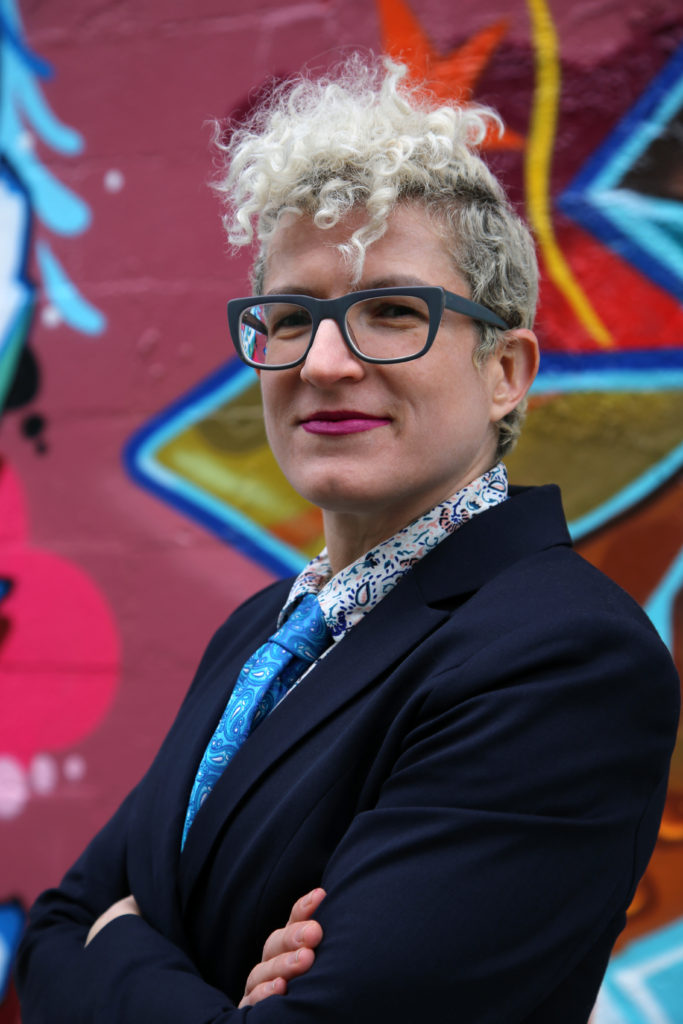
Linn Tonstad wearing a tailored jacket by T.M. Lewin and a graphic-floral collared shirt from Ann Taylor paired with an electric blue paisley tie “bought outside Perugia somewhere.” The charcoal rectangular eyewear offsets her signature magenta lip shade. (Photo: Stacie Joy)
“Perhaps in her stance is a certain kind of prance; perhaps in the energy that saturates her figure, she becomes an assembly. Look at her move: what a movement.”
–Sara Ahmed, Living a Feminist Life
***
Anyone who is serious about theology or religious asceticism may have their reservations about embracing fashion. Indeed, fashion’s emphasis on novelty, extravagance, and self-obsession seem distractedly opposed to the pursuit of eternal truths, spiritual discipline, and community often associated with religion. Hence the curious looks I get when I mention my research interests at the intersection of religion and fashion. But doesn’t this oppositional view keep our understanding of the sartorial superficial and, similar to other impasses between convention and contemporary life, limit our possibilities for doing religion and theology differently?
With these questions in mind, I sat down for a conversation with Linn Tonstad, Associate Professor of Theology, Religion, and Sexuality at Yale Divinity School. We met via Zoom on a June morning during COVID restrictions. I noticed right away the striking offset of Linn’s magenta lipstick and ivory-colored, wide-framed glasses, both familiar elements of her personal style. I smiled deeply recalling why I had pursued a conversation with her about theology and fashion. I find the tension between surprise and discipline in Linn’s look delightful – a gender-fluid silhouette one day, tailored the next, a well-tied knot foregrounded by contrasting patterns, a meticulous haircut paired with angular eyewear. Linn wears the paradoxes that fashion experts note is necessary between innovation and conformity, intelligibility and dissonance.
While Linn’s writing does not directly address fashion, her sartorial embodiment reflects the ways that academic communities and sanctuaries are trending toward divergence. I propose that these interruptions of dominant aesthetic regimes are a form of revelation, to use theological language, a mode of articulation that strikes at the heart of religious calls to uniformity. Linn is trained in systematics, an approach to theology that requires serious conviction in and methodological coherence with the classical lineage of Christian symbolism, belief, and practice. Linn’s scholarship on the interplay (or lack thereof) between Christian systematic theology and queer theory mirrors the provocative clashes of her embodied aesthetic. I sensed that Linn would have some experience with both inquiring looks and dismissals of her work for a presumed lack of seriousness. I was curious to know if she had thought about connections between these interventions.
Seriousness, survival, and discomfiture
Fashion studies scholar Otto von Busch observes that, “Fashion is a conflict in human beings’ souls as well as in the social settings of the public realm, and our clothes are the conflict-ridden interface between the two.” When I asked Linn about her relationship to sartorial expression, she reflected on the vulnerability of talking about clothes: “I’ve had a strong relationship to sartorial self-expression since I was probably about 16 years old, but there’s been a lot of changes over time too. In the different lives I’ve lived, there have been different selves, in so many directions, and it’s very personal for me to talk about it. It’s unusual for me to talk about something that I actually experience as that personal, which is why I was interested in doing this [interview] in a way. I was like, ‘OK, I think I’m ready to have this conversation.’”
Linn recounted several distinct lives she’s lived with corresponding sartorial regimes. Growing up in Norway, she found the “conformity and homogeneity” of “high-level bourgeois aesthetics…incredibly stultifying.” She described her “conversion to feminism” in college in Southern California as a counter-aesthetic move. “I decided that it was politically important not to be pretty. I moved into this phase of being between a club kid and a goth, where I dyed my hair every imaginable color. I was threatened with suspension from two different religious colleges for how I dressed.” Linn enjoyed observing people experience the extreme disjunction between her appearance and her intellectual interests and fluency. “As was described in the defense of me in one of these cases of threatened suspension, ‘She may look like she dances for a living, but she doesn’t.’ I found it both personally generative and politically important at the time. And then I went to grad school, right, as one does.”
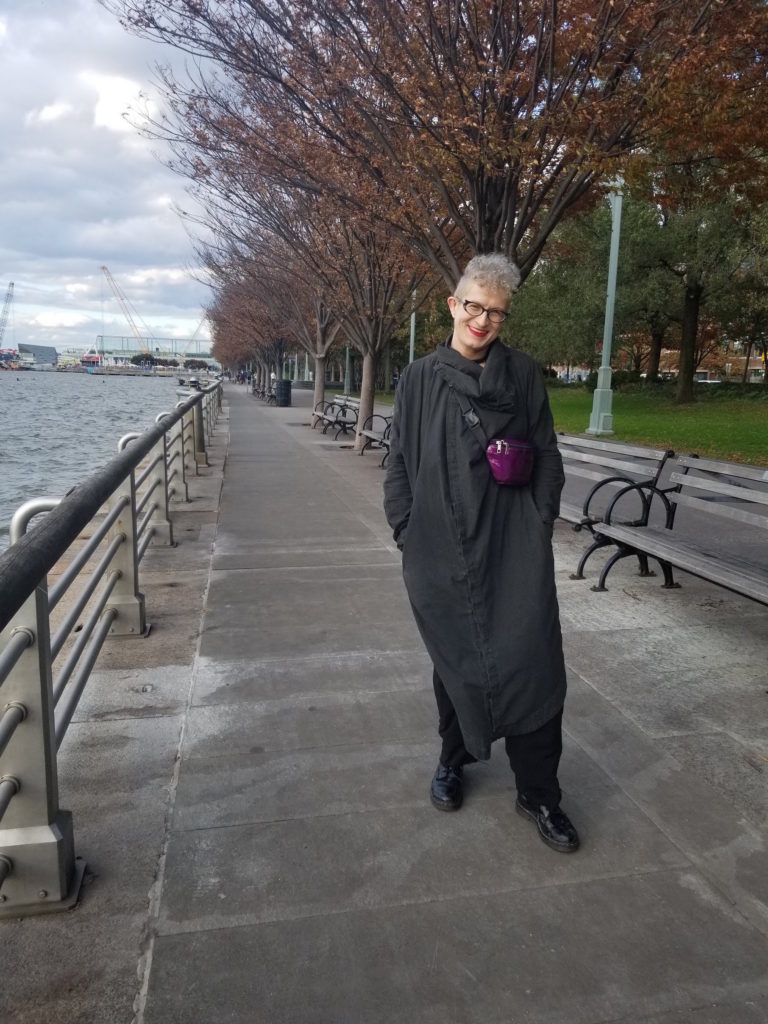
Linn wearing an asymmetrical coat by Army of Me, pants by Pal Offner, and Dr. Martens. The upper lash design on the eyewear, the purple fanny pack worn across the body, and the gloss finish on her shoes and bag all speak to Linn’s taste for gender play and surprising details. (Photo from Linn Tonstad’s personal archive)
In graduate school at Yale, Linn put on a high-femme style marked by stiletto heels, pencil skirts, and a curvy shape. “Changing my style as I did then felt like a question of survival, a needing to recalibrate the relationship between what I looked like and how I felt about what I did.” Linn’s femme aesthetic marked her ambivalence to the homosocial masculinity of theology as a discipline (“queer in a context where there was very little of that”), while also displaying her familiarity with the rules of the gender game. The ambivalent familiarity of her high-femme look was mirrored by her honesty about the “discomfiture” between systematic theology, feminism, and queer theory in her first book God and Difference. “Even now, a decade into my postgraduate career, I still get to sit around listening to people tell me how they really liked the sort of serious bits of the first book, but why is all that other stuff in there? And I also knew that because of that concern with continuity and intelligibility in systematics that if I wanted to survive in that discipline, I would have to show that I could play the game.”
The game here refers to the rules of systematic theology, which are to treat the symbols of the Christian faith with sufficient seriousness and to use them correctly. The aim of God and Difference is to show the failures of Christian thinking about God, gender, and sexuality through both a skillful handling of systematics and serious consideration of feminist and queer interpolations. As Linn writes, “This book is therefore also a critique of how getting the trinity right (e.g., speaking and praying Father rightly) becomes a pious cudgel protecting the wielder from seriously engaging the questions and concerns raised by those relegated to the pile of tares left to rot outside the church door.” Much of the broader discipline of theology remains unreceptive to this critique. With a tone of certainty, Linn said, “I am not the person who wrote that book anymore. I won’t write another one of the same kind and that has something to do with change, with what happens when you push a discipline as far as you think it can go, and then it simply refuses to go there.”
This discomfiture is made visible in contrast to the uniform of the theological academy. Linn and I commiserated over the standard issue attire at professional conferences. She recalled a photo-op at a conference a few months before the shutdown. “I’m standing there with five men who are all literally wearing the exact same outfit, the blue suit, brown shoes, and then the slightly patterned shirt underneath. Some of [the shirts] had smaller checks and some of them had larger checks, but that was the only difference. And they were different ages, different seniority, different races, five men, five exact same outfits and then me and that experience is an experience where there’s a way in which the body seems to disappear. Race makes a difference here, of course, but there’s a way in which the body seems to disappear for them. And it doesn’t for others.”
Doing theology differently
What if the change of outfits inherent to our lives could open our eyes to the changes that religious systems endure to survive, a realization that allows for what queer theologian Marcella Althaus-Reid named “a continuous process of serious doubting” rather than an obstinate fidelity to matchy-matchy systematic coherence? Marcella Althaus-Reid, a key conversation partner in Linn’s work, spoke frequently about attire as revelation. Linn mused about Althaus-Reid that, “Everybody remembers the theology without underwear. Everybody remembers lifting the skirts of Jesus. Everybody remembers going to gay bars with rosaries in your pocket.” For those not familiar with queer theology, what matters here is the methodological disruption of these material interlocutions in Althaus-Reid’s writing. One example, “doing theology without underwear,” treats the embodied experience and expressions of the lemon vendors (code for sex workers) in Buenos Aires as revelatory. Clothing (or lack thereof) reveals the particular and embodied ways that people imagine, relate to, and inhabit God. In turn, these material utterances reveal God’s preference for the disenfranchised, the exiled, and divine delight in deviance and nonconformity, what Althaus-Reid calls “indececency.” With these incarnational turns, Althaus-Reid affectively shifts the location of theological agency and authority from the capital-C-Church to the street.
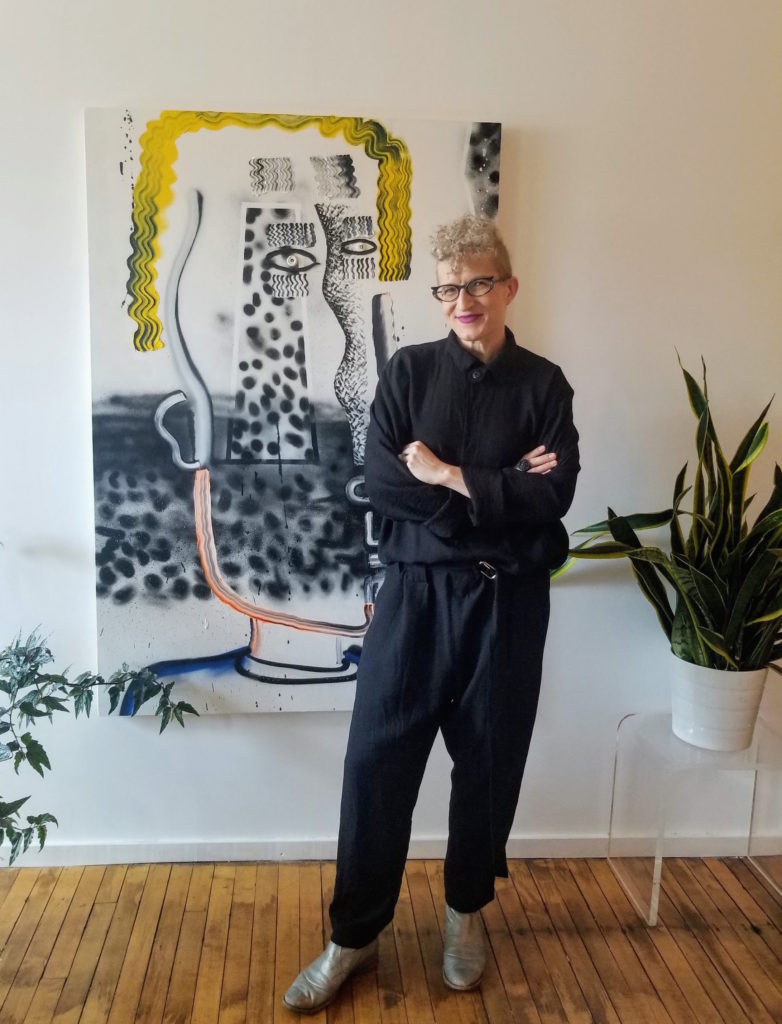
Linn in a David Road jumpsuit and silver Kenneth Cole boots. Graphic eyewear complements the Annie Hémond Hotte painting in the backdrop. (Photo from Linn Tonstad’s personal archive)
Linn notes the methodological importance of these moves, but she is not convinced by other scholars’ attempts to reinvent Althaus-Reid’s approach. “The way that it’s taken up, it just becomes a repetition of the anecdote or another debate over the sort of ethics of the theology without underwear imagery, the lemon vendors, how exploitive is this and how does it relate to Afro-indigeneity. And those are all legitimate questions, but I have seen relatively little writing still that tries to do another version of what she’s doing there.”
Linn laments this mimicry and how it relates to other challenges in the field and in her own work. She mulled over embodiment as an impossible subject for humanities scholars. “In the ways that we write about it, we utterly deny everything that we’re saying. Because the moment we write about the body, we have already reified it and made it external to ourselves in ways that are really, really hard to overcome. I’m thinking a lot about this in my current work and not successfully resolving it at all. Like, how would you have to write if you wanted to write the body? One of the points about the body and fashion in that regard, is that it isn’t just how we know each other. It’s the what of knowing each other.”
When I asked Linn what she is wearing lately, her response necessitated disclosing what she is doing with her body and how what she is doing matters for responding differently to current dilemmas in theology. “In recent years in my personal life I have more and more this sort of uniform of raving, of techno, like loose clothing, the Docs [Dr. Marten boots], you know, black pants, and sort of cloaks.” Street scenes from Linn’s social media feed flashed in my memory, one in particular where she takes a wide stance, head tilted. She’s wearing a long, fluid, dark-colored coat with an asymmetrical closure and hemline, and white chunky boots. I remember feeling how righteous she looked, how her stance became her, so obviously herself. “I’ve been trying to start writing about dancing because that’s been such an important part of my life until shutdown of course happened.” Linn confides, “I don’t know if it’s going to work.”
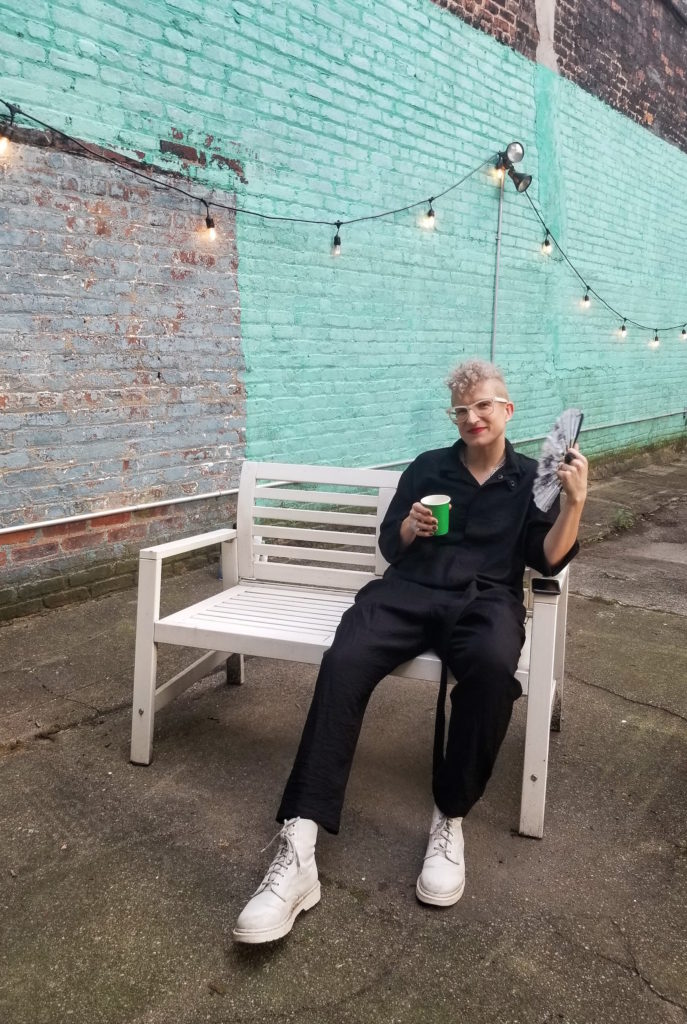
Linn lounging in a black jumpsuit by David Road and white Dr. Martens. Accessories include a black ring Linn found at a vintage store in Melbourne and a sparkly plastic ring from Claire’s circa “many many years ago.” Styling intermingles soft and hard elements – ivory glasses, heavy metal chain, floral fan, dark nail polish, loose fabric, and lace-bound footwear. (Photo from Linn Tonstad’s personal archive)
She is skeptical of “standard straight confessional kinds of storytelling” like the disclosures of identity made in response to Althaus-Reid and Eve Sedgwick’s observation that queer has to be said in the first person. Nonetheless, her dancing life is becoming a genre-bending space of experimentation in Linn’s writing life. She asks herself, “What are other kinds of stories that you could tell?” And this question opens up a different field of experience for her and potentially for theology. “One of the things you contribute to a really good dance floor is visually, the visual interestingness of you.” For Linn, the dance floor counters standardization and imperatives to check identity boxes. “The very best dance floors will have an incredible array of moments that are clearly chosen, both to enhance self-expression and to enrichen. To make it sometimes literally more colorful, what everybody is experiencing in dance floors that are made simply by everybody being themselves real hard, right, which is the best kind of dance floor. I don’t know how to write about that for theology, like I’m trying, but it feels incredibly clunky and hard. Also necessary, I think.”
This necessity is not self-indulgent. Linn reflected on what is at stake when theologians and institutions fail to pay attention to “how bodies encounter each other” and “the way bodies move through space differently.” For her, the repeated claims that “injustice is bad” and “racism is against God’s will” are insufficient responses to racialized violence, as are recourse to established theological solutions. One example she gave is the tendency of Christian theologians who propose liturgy (rites of Christian initiation, formation, and worship) as a way to break the habits of racism. This solution falls short considering that liturgy is designed to instill obedience and conformity to a system of divine and clerical supremacy. Her voice rose in exasperation, “It’s like theologians are determined to prove that Christianity is a lie. They’re determined because they will not give on some of these questions. The doubling down and the ways that the unseriousness with which these problems get treated, usually under the veneer of seriousness, right? It’s like, ‘We are taking this problem seriously. We are establishing the commission to talk about this, that, and the other.’ All of that is evasion.”
As Linn sees it, knowing and changing “how bodies move through space or are forbidden to move through space” is imperative to redress racialized violence in the classroom, in the hallways of the university, in policing, in the geographic demarcations and colonial practices in New Haven, Connecticut where she teaches. “How do we change the way we feel? How do we change the way we interact in an embodied life? Those questions aren’t answered at all.”
“Everybody being themselves real hard”
Fashion, dance, and other embodied genres have the potential to open us to our own stories, to our wounds of resistance and conformity, and our movements to make life more livable for ourselves and others. As Linn reflected, “It’s interesting to have different selves in different periods and see how they work in the context of a work life where it’s important for students to see that you can survive without, I mean, I don’t want my students to give up as much as I did. I want their lives, their trajectories to be less stifling than I experienced grad school as.” What to wear, then, is a serious concern. In present conditions, what to wear can be the difference between securing a livelihood or experiencing professional excommunication, the difference between being taken seriously or being shot for trespassing.
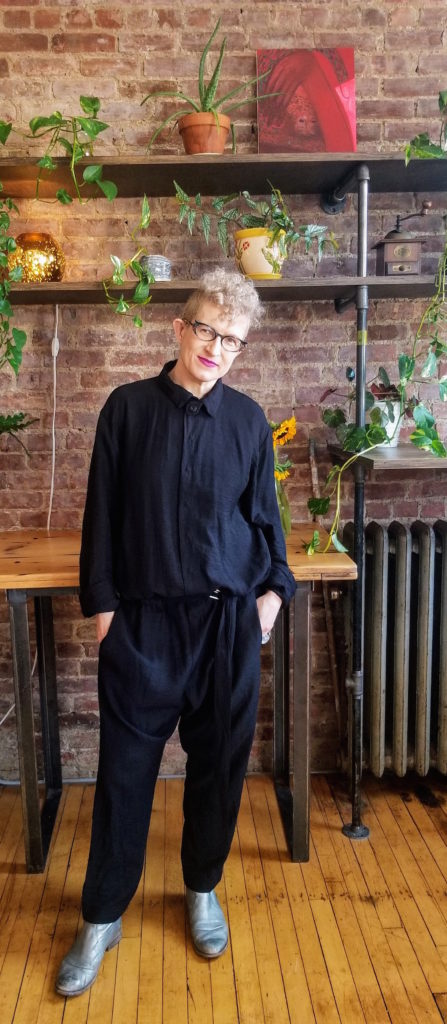
Linn in a David Road jumpsuit and silver Kenneth Cole boots. The reds in the Avery Z. Nelson painting in the background catch on Linn’s magenta lip color and draw attention to her multilayered facial expression, head tilt, and stance. (Photo from Linn Tonstad’s archive)
In optimal conditions, what to wear can, as fashion studies scholar Elizabeth Wilson observes, make a new cultural order out of the contingent, decorative, and futile. Or as Linn suggests, “The best dance floor isn’t the one that’s just harmony. Everybody doing the same thing. The best dance floor is one where there’s real divergence and even conflict to some extent. I like the unexpected combination. I like the intractable conflict, but it has to be acknowledged as a conflict. It can’t just be sublimated into. There needs to be a willingness to act as if we thought there was something at stake.”
My conversation with Linn, at the very least, attests to the power of dress to disclose the seams between personal and intellectual convictions. Optimally, more serious attention to the intractable conflict between the contingency of fashion and the obstinacy of theology may supply visual interestingness and unexpected delight to systems in need of change. So while the uniforms grip their cudgels, the queer contingent laces up their boots, reapplies their lipstick, and dances to that deep break beat, knowing their lives depend on it.
Jeanine Viau is an Associate Lecturer of Religion and Cultural Studies at the University of Central Florida.
***
Published with support from the Henry R. Luce Initiative on Religion in International Affairs.